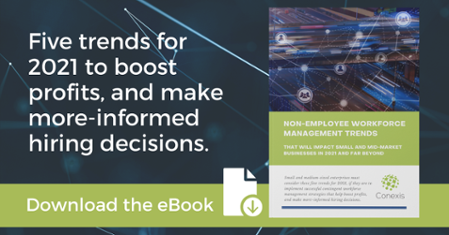Supply chains for most organizations have grown exponentially in recent years. In fact, a large number of businesses can now only hazard a guess at how many vendors they have on their books, with the true figure generally unknown.
Because of this, vendor management software is more critical to the success of an Organizations non-employee workforce management program than ever before. Effective vendor management ensures your company makes the most of its vendor relationships, while at the same time maximizing the benefits and mitigating the risks.
That’s why, according to Ardent Partners, The State of Contingent Workforce Management 2020, most organizations will be focusing on using vendor management systems (VMS) over the next two years to gain control of their contingent workforce program and automate/consolidate the processes associated with it - with 60 percent of businesses focusing on data analytics and reporting.
With that in mind, this blog will dive deeper into what vendor management actually is, why it’s crucial for vendor management success to move away from manual spreadsheets and how using technology can transform how you manage your vendors.
What exactly is vendor management?
Vendor management is the process that businesses use to strategically manage their vendors. This includes every step in the vendor management lifecycle, from sourcing vendors, negotiating contracts, mitigating risk, analyzing vendor performance and offboarding.
When it comes to a company’s contingent workforce management program, vendor management is the process of managing the entire staffing vendor (also known as staffing firms or staffing agencies) lifecycle.
Staffing agencies work on behalf of an organization to match temporary workers or independent contractors with relevant non-employee positions within the business. This access to non-employee workers gives businesses the ability to scale up rapidly depending on current workforce requirements, and access hot skills within their industry.
There are a few steps in the vendor management process:
- Vendor selection
- Risk assessment
- Contract negotiation
- Onboarding
- Managing/monitoring performance, and mitigating risk
- Ooffboarding
Through successful vendor management in their non-employee workforce program, organizations can realize significant soft and hard savings, as well as benefits such as better performance and monitor tracking, improved vendor visibility and significant efficiency gains.
Why your organization needs to move away from using manual spreadsheets to manage vendors
Unfortunately, most organizations aren’t able to access the above benefits as they are still managing vendor data locally - using spreadsheets, in-house databases or Sharepoint-like websites to manage their staffing agencies.
In fact, according to a study conducted by Forrester Research, 82 percent of businesses claim that they still use spreadsheets to inventory, assess, and manage third-party companies.
These outdated and manual systems for vendor management are simply not an effective way to manage a company’s staffing agencies.
Using these time-consuming and error prone methods leads to a lack of visibility into vendor information and vendor performance that impacts your entire non-employee workforce strategy. The result is wasted time, a lack of vendor consolidation that leads to hidden risks, no insight into how vendors are performing, rogue spend across your contingent workforce program and significant room for human error.
Looking for more information on why manual spreadsheets aren’t effective for managing staffing vendors? Read our blog, ‘5 dangers of Using Manual Spreadsheets to Manage Staffing Vendors’.
How automating your vendor management leads to huge ROI
To revolutionize how you manage your vendors, vendor management best practices calls for the implementation of cloud or web-based vendor management software.
A vendor management system (VMS) will automate your entire vendor process in one centralized software platform, allowing you to monitor the performance of your staffing suppliers from request to payment.
By consolidating both your vendors and all contingent workforce program data in one centralized location, your organization will have clear visibility and control over its vendor relationships, vendor analytics, pay rates and much more.
The result is significant cost savings, standardized processes set for all hiring managers across your organization, improved efficiencies and more strategic insights into how your vendors are performing.
Want to learn more about the benefits of a vendor management system? Contact Conexis VMS today. We’ve built a VMS platform designed specifically for organizations with smaller contingent workforce management budgets.




